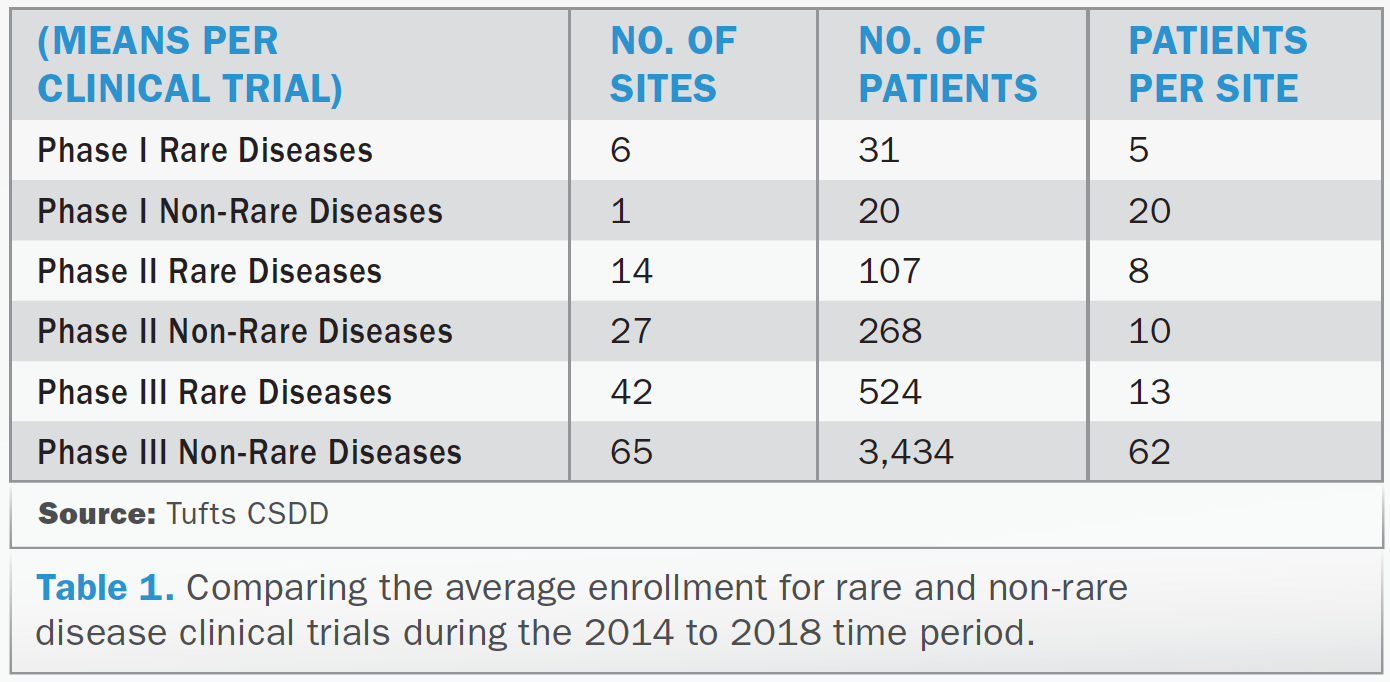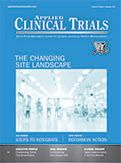Proliferation of Rare Disease R&D Necessitating Novel Strategies
Applied Clinical Trials
Interest in benchmark data on the scope, performance, and economics of rare disease drug development efforts has grown.
Kenneth A. Getz

Nearly every week, the Tufts Center for the Study of Drug Development (Tufts CSDD) receives a request for benchmark data on rare disease drug development performance and economics. These benchmarks have been hard to come by, as a large percentage of companies active in this space are privately held. Sponsor companies and contract research organizations (CROs) have been looking for this benchmark data to guide portfolio and development project planning and optimization. Tufts CSDD has compiled some useful benchmarks.
At the present time, rare disease drug development is one of the most active and fastest growing areas in drug R&D. Rare diseases are defined as medical conditions that affect 200,000 or fewer people in the U.S. or fewer than five people per 10,000 population in the European Union. In 2018, approximately one-third (31%) of all products in the global R&D pipeline targeted treatments for rare disease indications. This is up from 15% only 10 years ago. And nearly six-out-of-10 (58%) drug and biologic approvals in 2018 were for rare diseases; up from 26% in 2008.
Biopharmaceutical companies have substantially increased R&D investment in rare diseases, not only to meet unmet medical needs, but also to support development programs at lower relative cost, with fewer competitors, strong demand from patient advocates, and greater opportunities for favorable pricing. This latter expectation in particular appears aspirational given current public perceptions and the political climate.
As more data is gathered characterizing the scope, performance, and economics of rare disease drug development, the opportunity for pharmaceutical and biotechnology companies appears more nuanced. Recent Tufts CSDD research suggests that rare disease drug development presents scientific and operational challenges that will necessitate-and perhaps accelerate-the adoption of novel and less traditional clinical development strategies, operating practices, and solutions. Consider a few key findings:
- The average direct cost to conduct a Phase III pivotal trial of an investigational rare disease treatment is approximately half that of investigational treatments for non-rare diseases ($103 million vs. $193 million).
- Although clinical trials for rare disease drugs recruit fewer patients, clinical phase through approval durations for rare disease drug development take, on average, four years longer than those for non-rare diseases due to site and patient recruitment and retention challenges.
What follows are benchmarks that Tufts CSDD-and others-have been compiling. We analyzed data on 4,562 clinical trials for all rare disease medicines in active FDA-regulated clinical trials worldwide between 2014 and 2018. This data was gathered from the www.clinicaltrials.gov website. Data on the economics of rare disease drug development comes from EvaluatePharma. The author thanks Beth Harper (Clinical Performance Partners) for her input and assistance on analyzing rare disease clinical trial recruitment and retention rates.
Clinical trial challenges and their Impact
Sponsor-company investment in R&D for rare diseases has seen substantial growth in global, FDA-regulated Phase I-III clinical trial activity. In total, between 2014 and 2018, there have been more than 4,000 FDA-regulated clinical trials initiated worldwide for rare disease treatments. In 2018 alone, there were 372 new Phase I clinical trial starts; 422 new Phase II clinical trial starts; and 148 new Phase III clinical trial starts.
The vast majority (84%) of active studies on rare diseases are currently in early-stage clinical development. But sustained long-term pharmaceutical company investment in rare diseases is driving up the volume of later-stage clinical trial activity. New clinical trials initiated for Phase II and III clinical trials are increasing at three times the rate as those for Phase I trials (12% vs. 4%).
Pharmaceutical companies and CROs have noted the unprecedented challenges they face in finding clinical research professionals with expertise and experience in specific rare diseases and in identifying and enrolling patients who are managing and living with specific rare diseases. To address these challenges, sponsors and CROs have typically engaged a much larger relative number of clinical investigators in early-stage clinical trials to each enroll a smaller number of patients. To put this into perspective and characterize the magnitude of this challenge during the 2014 – 2018 timeframe (see Table 1):
- For Phase I clinical trials of rare diseases, sponsors and CROs engaged, on average, six times the number of investigative sites to recruit one quarter of the number of patients per study, compared with those for non-rare diseases.
- For Phase II and III clinical trials of rare diseases, sponsors and CROs engaged half to 60% of the average total number of investigative sites, respectively, to enroll as few as 15% of the total average number of study volunteers per trial.

The challenges associated with rare disease patient recruitment and retention are even clearer in the substantially higher observed screen and randomization failure rates relative to those rates for non-rare diseases. Eight-out-of-10 (81%) patients screened for clinical trials for rare diseases are not eligible to enroll, compared to 57% screen failure rates for non-rare diseases (all therapeutic areas). More than half (56%) of rare disease study volunteers fail to be randomized, compared to 36% randomization failure rates for non-rare diseases.
But once rare disease patients have enrolled in a clinical trial, they’re far less likely to drop out. The premature termination rate-associated with all causes-of rare disease patients randomized for clinical trials is 14%, compared to 21% for those in non-rare disease clinical trials.
Drug development and approval durations
Major difficulties finding and engaging investigative sites and identifying and enrolling study volunteers in rare disease clinical trials adds considerable time and delays recouping development investment. Overall development durations (i.e., IND filing to regulatory decision) for rare disease applications are four years longer than for all other disease segments.
Between 2014 and 2018, clinical durations-overall Phase I-III cycle time-for rare disease investigational drugs took 131 months, on average. This was 68% longer than the average 78 months for all non-rare diseases. Rare disease clinical durations are longer in every therapeutic class observed during the 2014-2018 period: for example, they were 41% longer for all cancer-related diseases; 79% longer for all endocrine diseases; and 64% longer for CNS diseases.
Given unmet medical need, regulatory review durations are four months faster, on average, for rare disease drug applications, compared to review time for non-rare diseases across all therapeutic areas. Submission to approval decisions for rare disease drug applications are 47% faster in CNS diseases; 30% faster in endocrine diseases; and 10% in cancer-related illnesses.
Responding to a new risk-return profile
The high proportion of rare diseases in R&D and the growing number achieving commercialization will necessitate the adoption of new clinical development models to accelerate timelines and drive greater efficiency. Very small relative markets and long relative development durations challenge the traditional risk-return profile for new drug therapies.
Worldwide, in 2018 an estimated 3,500 small and large molecules targeting rare diseases were active in R&D. This is more than double the level observed 10 years ago. And during the past 25 years, there has been a six-fold increase in the number of orphan designations granted by the FDA-growing from 301 designations in the four-year timeframe between 1994 to 1998 to 1,800 designations in the 2014 to 2018 period. As the volume of designations has increased, so too has the absolute number of approvals: The total number of orphan drug approvals increased from 84 in the 1994 to 1998 timeframe to 316 in the 2014 to 2018 period.

Analysts and observers anticipate that sponsor company reliance on data and sophisticated analytics to identify rare disease-focused investigators and eligible patients will intensify. The adoption of patient-centric approaches is also expected to accelerate. Sponsors and CROs will increasingly look to virtual (direct-to-patient) and hybrid (investigative site with intermittent direct-to-patient) models and convenience-enhancing approaches (e.g., home nursing, telemedicine, wearable and mobile devices, and patient assistance programs) to bring clinical trials to wherever it is easiest and the most efficient for study volunteers to participate. Observers and analysts also expect sponsor and CRO demand for clinical trials embedded within clinical care settings to increase, as will demand for real-world data and evidence to supplement, and even replace, traditional clinical research data.
And at Tufts CSDD, we can expect a growing number of inquiries into baseline and benchmark data on the impact of these approaches on rare disease drug development performance and economics.
Ken Getz, MBA, is the Director of Sponsored Research at the Tufts CSDD and Chairman of CISCRP, both based in Boston, MA. email: kenneth.getz@tufts.edu

Including Women of Childbearing Age in Clinical Research
March 26th 2024In recognition of International Women's Month, we're featuring this recent talk between Associate Editor Miranda Schmalfuhs and Marie Teil, Global Head of UCB’s Women of Childbearing Age Program. They speak about the specific challenges women with chronic illnesses face when accessing appropriate treatment and participating in clinical trials, UCB's Women of Childbearing Age Program and it’s most successful strategies, and much more.
Regulatory Compliance With eCOAs
April 26th 2024In the fourth and final part of this video interview with ACT editor Andy Studna, Melissa Mooney, director, eCOA sales engineering, IQVIA discusses how the regulatory stance on electronic clinical outcome assessments has changed over the years and what it could look like in the future.
Improving Engagement While Maintaining Data Integrity & Validity
March 19th 2024In recognition of Women's Health Month, we're featuring this recent talk between Associate Editor Miranda Schmalfuhs and uMotif's Chief Product Officer, Julia Lakeland, discuss new technologies improving patient engagement and reducing the emotional and logistical burdens of participation, ethical considerations that should be addressed when implementing those technologies, while ensuring patient privacy, and much more.
Using Patient Reported Outcomes in Dermatology Trials
April 25th 2024In part 3 of this video interview with ACT editor Andy Studna, Melissa Mooney, director, eCOA sales engineering, IQVIA sheds light on the unique challenges of dermatology trials and how clinical outcome assessments can be implemented in them.